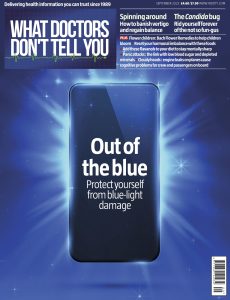
What Doctors Don’t Tell You – September 2023
English | 70 pages | pdf | 30.4 MB
Welcome at What Doctors Don’t Tell You Magazine September 2023 Issue
Technology and the need to sit for long periods staring at computers, phones and other electronic devices have affected our biology inmyriad ways, causing a raft of syndromes to afflict our backs, necks, spines, arms, wrists, hips and more.
But the latest evidence is not about skeletal or muscular issues, but the long-term effect of exposing ourselves to blue light.
All artificial light isn’t great for us, but some of the worst is blue light—so called because these short wavelengths in the ultraviolet spectrum are especially hard on our bodies, especially our eyes.
We are exposed to blue light on a near-constant basis. Although the greatest source of blue light is still the sun, natural blue light is greatly compounded by the ever-present short-wave UV lightemitted by laptops, smartphones, computer monitors and tablets, not to mention TV, fluorescent and compact fluorescent light (CFL), and light-emitting diode (LED) light bulbs.
The main problem, as covered in detail in our Special Report (page 26), has to do with the effect of massive exposure to this light— at the high-energy end of the visual spectrum—on the eyes, exposure levels that humans have never had to deal with before.
Issues related to blue light first appeared when LED lights arrived shortly after the millennium, and eye doctors came across increasing numbers of cases of eye injury from blue light—even in children from toys that emit LED light.
The magazine issue was potential damage to the human retinal ganglion cells, a worrying situation since these neurons are responsible for transferring information that the eye sees to the brain.
It may be time to revise what scientists and doctors regard as safe. Recent evidence from animal studies has shown that at levels of exposure deemed safe, animals still suffer degraded cells in the retina.
But that isn’t the only issue. Blue light also increases oxidative stress and the production of reactive oxygen species—highly reactive chemicals formed from oxygen that have a central role in everything from asthma and diabetes to cancer. These chemicals are also implicated in a host of eye conditions, including glaucoma, cataracts, diabetic retinopathy and age-relatedmacular degeneration.
In fact, ophthalmology associations now concede that the constant use of computers and smartphones could be creating an epidemic of nearsightedness in children.
Besides eye problems, our electronic devices interfere with levels of melatonin produced by the pineal gland after just a few hours of use. Ordinarily, when it gets darker, the body produces more melatonin, which causes us to become sleepy. But exposure to blue light, particularly in the evening, suppresses this natural circadian rhythm created by the production of melatonin and other hormones.
Too little melatonin and consequent insomnia can lead to another host of illnesses, included neurodegenerative diseases like Alzheimer’s and even cancer. Happily, there are ways to minimize your exposure, as our Special Report notes in detail. Many companies produce blue, yellow and amber light glasses these days, which they claim will block 50–100 percent of blue light. And studies of the available literature bear out their light blocking effectiveness far more than the evidence to date for downloadable blue screen filters.
Some companies exclusively devoted to creating blue-lightfiltering glasses produce clear glasses with special lenses to filter out about half of blue light during daylight hours, from artificial light to screens, with yellow offering maximum daylight protection (about 70 percent). Amber for nighttime helps increase melatonin levels and sleep quality by blocking 100 percent of blue light in the 400–500 nm range.
Finally, red glasses, the greatest blockers, to be used two to three hours before sleep, are claimed to be the most powerful blue-light lenses of all. They block out both blue and green light up to 550 nm, which also disrupts melatonin production and sleep.
There’s a variety of supplements you can take to minimize bluelight damage and restore your melatonin levels, too. Antioxidants like vitamin A, vitamin C, lutein and zeaxanthin, N-acetyl cysteine and coenzyme Q10, all long known to be good for the eyes, can prevent both oxidative stress and photoreceptor degeneration. Numerous flavanols, spices like curcumin, omega-3 fatty acids and even probiotics that are good for the eyes have been shown to prevent blue-light eye damage.
Besides these precautions, it’s vital for you—and your children or grandchildren—to follow all the guidelines for safe use of devices: keep them at arm’s length, use them in areas with normal light, take frequent breaks, limit their use and keep away from them a few hours before bedtime.
There’s also one extremely simple solution that will mitigate the artificial blue light taking over our lives and can even help prevent nearsightedness in children: spend as much time as you can outdoors.
Nothing we can produce on an electronic machine can beat the health-giving effects of good old natural daylight.
Editors Letter
Download from: